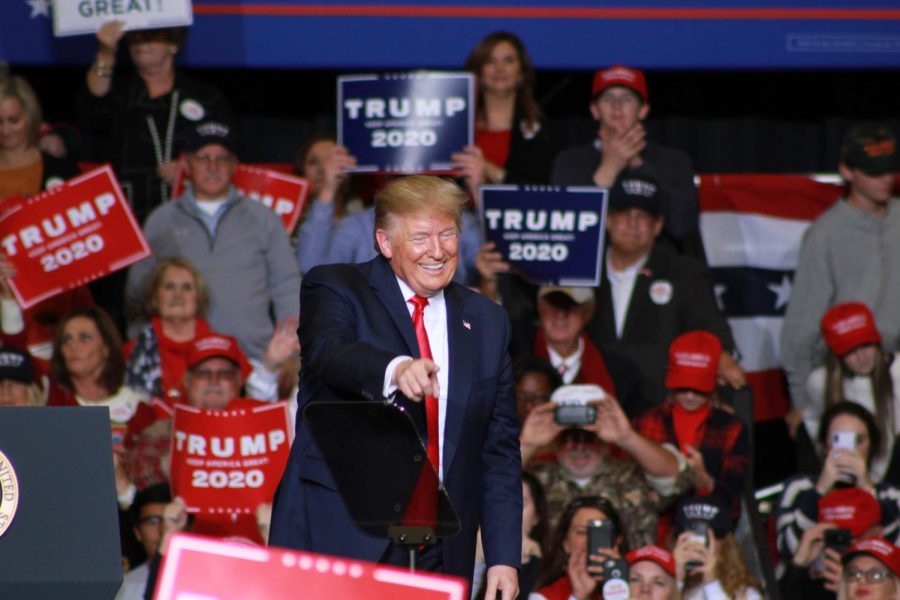The peace plan to prevent peace
Trump speaks about his major points in his Middle East plan.
February 6, 2020
The Trump administration, with Israeli Prime Minister Benjamin Netanyahu, has revealed the long-awaited Middle East plan intended to guide Israel and Palestine towards a more peaceful coexistence. So far, all it has done is emphasize their divide.
At no point during the plan’s crafting was Palestine consulted, so, as one might expect, its contents heavily favor Israeli priorities. While that in itself screams problematic, the fact that such an obviously impractical document was unironically introduced as a “bigger and better deal” to broker peace than anyone could imagine, begs critics writing highly acclaimed opinion articles to dramatically spotlight the not-so-invisible forces driving the chaos
The proud, though notably defensive, author of this grand plan is Trump’s son-in-law Jared Kushner. Tasked with solving the Middle East in 2017, Kuschner, then 36, had the impressive qualifications of being Jewish and from a family who has long been friends with Netanyahu.
Perhaps a demonstration of his refined political finesse is in order. In an attempt to approach the problem of actually getting Palestine on board, Kuchner memorably told CNN: if the Palestinians reject his plan, “they’re going to screw up another opportunity, like they’ve screwed up every other opportunity that they’ve ever had in their existence.” That’s it. He has won their favor.
For an idea of the opportunity Palestine is missing out on, here is an overview of a couple of the plan’s more significant points.
The document includes a framework of the generally advocated for two-state solution which aims for Israel and Palestine to both exist as sovereign states alongside each other. It gets complicated, however, with the included maps clarifying potential ownership of territory. Currently, Palestine occupies the Gaza Strip and the West Bank. The proposed map creates “enclaves” throughout the West Bank, connecting a series of Israeli settlements which have been condemned internationally as illegal expansions onto Palestinian territory.
In 2017, the U.S. formally recognized Jerusalem as Israel’s capital, causing Palestine to cut ties with the Trump administration. Palestinians have long occupied East Jerusalem, which contains the old city as well as several Muslim, Jewish and Christian holy sites. One of their goals is for East Jerusalem to be formally recognized as their capital. The Middle East plan would give Israel full control over the entirety of Jerusalem while Palestine would be allowed a capital in Abu Dis, a village in the eastern outskirts of the holy city.
There are a number of other conflicts of ownership and authority addressed in essentially the same manner as what can be seen above: Israel gets what they want while Palestine doesn’t. Israel has agreed on a four-year land freeze during which Palestine will be given time to take the offer, though it’s unlikely they will. Instead, expect to see stronger demands from the Palestinians, making future peace plans –real ones– even more difficult to create.
And really, it’s no wonder Palestine wasn’t exactly thrilled at the proposal. President Mahmoud Abbas of the Palestinian Authority in particular recognizes an inevitable end to his rule should he give in to this U.S. plan intended to corner Palestine into submission.
So who actually benefits from this plan? Well one major suspicion, encouraged by the timing of the plan’s announcement, is that this is meant to help Netanyahu win the general election planned for March 2. The prime minister has charges of bribery, fraud, and breach of trust standing against him, and with the past two Israeli election cycles having been inconclusive, the country’s government is currently in unstable condition. Similarly, Trump has faced impeachment trials as the election to determine his future in office approaches. For both, the plan and its intended representation of strength and progress could add some positive light to their campaigns.
Another major push for this plan comes from within the States. Evangelical Christians were strong financial supporters of the Trump campaign in 2016, largely due to Mike Pence’s many promises to incorporate his personal Christian ideals into the administration’s decision-making process. The Evangelical push would have the existence of a sovereign Israeli state be dominant to a Palestinian one.
Other powerful domestic pro-Israel lobbyists include AIPAC, who has shown support for the plan, and casino billionare Sheldon Adelson, who contributed $20 million to the Trump campaign and has already offered to pay for a new U.S. embassy in Jerusalem. Nice to know it only takes some pocket change and a positive attitude to have your political voice be heard.
To expect this plan to make any improvements to the status of peace in Israel would be to severely overestimate its contents. It is important to acknowledge the document as both a way to divert the public’s attention from Trump’s impeachment trials and Netanyahu’s failing elections, as well as a move intended to solidify the favor of the Evangelical monetary powers behind the Trump administration. Of course, these forces are nothing new, but sometimes the change they bring about is a bit more obvious, a not-so-pleasant reminder to pay attention.
Editor’s note: The author of this piece asked for their name to be removed due to safety issues following their graduation.








